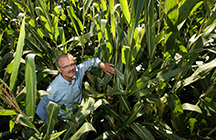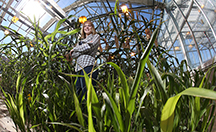March 7, 2016
Modern corn hybrids more resilient to nitrogen stress, crowded planting conditions
 |
|
Tony Vyn (Purdue Agricultural Communication/Tom Campbell) |
WEST LAFAYETTE, Ind. - Modern corn hybrids produce more plant material and take up, on average, the same amount of nitrogen as earlier varieties, in spite of being more crowded and having less nitrogen available per plant, a Purdue University review finds.
In an analysis of 86 field experiments, agronomists found that corn hybrids released after 1990 prove more resilient than their predecessors in multiple ways. Modern hybrids maintain per-plant yield in environments with low nitrogen, can bounce back from mid-season stress and have an improved ability to take up nitrogen after silking, even if they suffered from nitrogen deficiency during flowering.
The study suggests reserving a portion of nitrogen fertilizer to apply later in the season could be a good bet for growers, said Tony Vyn, professor of agronomy.
 |
|
Agronomy doctoral student Sarah Mueller studies how modern corn hybrids respond to nitrogen stress. (Purdue Agricultural Communication/Tom Campbell) |
"This is like insurance," he said. "Previously, withholding some of your nitrogen for later could be perceived as a risky venture - you don't want to inadvertently cause nitrogen deficiency. But this paper suggests that with modern hybrids, that risk is lower."
Nitrogen is an essential building block of plant proteins and plays a vital role in boosting grain yields. It's also notoriously mobile, said Sarah Mueller, doctoral student in agronomy and first author of the study.
"Once that nitrogen is in the soil, you start losing it," she said.
Growers want to keep the costly fertilizer in their fields and crops and prevent the loss of excess nitrogen to the atmosphere and water systems where it can cause environmental damage. But synchronizing nitrogen applications with plants' nitrogen uptake remains a challenge.
Mueller and Vyn's review offers valuable insights into how modern corn hybrids differ from pre-1990 varieties in their uptake of nitrogen and response to nitrogen deficiencies. Understanding these differences can help growers improve corn yields by maximizing nitrogen accumulation and applying nitrogen fertilizers more efficiently.
The study showed modern hybrids do more with less: They maintain grain yield on a per plant basis even when planted at higher densities than their predecessors - an average of 30,000 plants per acre compared with 20,000 - and despite average nitrogen fertilizer application rates remaining the same.
"These plants are able to maintain yield in the face of plant density stress and nitrogen stress," Mueller said. "That's pretty impressive and speaks to the overall resilience gains of modern hybrids."
The research also shows modern hybrids take up a substantial amount of new nitrogen as their grain develops. Modern corn hybrids take up about 36 percent of their total nitrogen after silking, compared with about 30 percent in older hybrids.
This late-season nitrogen uptake raises questions about whether splitting nitrogen fertilizer applications - rather than applying once early in the season - is a viable option for growers.
"These fundamental genetic changes could give us the opportunity for more flexibility in timing nitrogen applications," Vyn said. "We're researching this further because there could be gains in nitrogen fertilizer efficiency that could improve corn productivity and benefit the environment."
Vyn and Mueller cautioned that growers shouldn't shortchange their nitrogen applications, trusting modern hybrids to recuperate, but rather think about how reserving some nitrogen for later might prove advantageous in both optimum and adverse growing conditions.
Forty-three percent of the experiments analyzed were in the United States, and 32 percent were in China, with the remainder spread across the globe.
The paper was published in Frontiers in Plant Science and is available at http://journal.frontiersin.org/article/10.3389/fpls.2016.00053/full.
Sarah Mueller's work was funded by an Indiana Corn Marketing Council Graduate Student Research Assistantship.
Writer: Natalie van Hoose, 765-496-2050, nvanhoos@purdue.edu
Sources: Tony Vyn, 765-496-3757, tvyn@purdue.edu
Sarah Mueller, smuelle@purdue.edu
ABSTRACT
Maize Plant Resilience to N Stress and Post-Silking N Capacity Changes over Time: A Review
Sarah M. Mueller; Tony J. Vyn
Agronomy Department, Purdue University, West Lafayette, IN 47907, USA
E-mail: tvyn@purdue.edu
We conducted a synthesis analysis on data from 86 published field experiments conducted from 1903 to 2014 to explore the specific consequences of post-silking N accumulation (PostN) in New Era vs. Old Era hybrids on grain yield (GY) and recovery from plant N stress at flowering (R1 stage). The Old Era encompassed studies using genotypes released before, and including, 1990 and the New Era included all studies using genotypes released from 1991 to 2014. Mean N fertilizer rates for experiments in the Old and New Era were similar (170 and 172 kg ha−1, respectively), but plant densities averaged 5.0 plants m−2 in the Old Era vs. 7.3 plants m−2 in the New Era studies. Whole-plant N stress at R1 for each hybrid, environment and management combination was ranked into one of three categories relative to the N Nutrition Index (NNI). The key findings from this analysis are: (i) New Era genotypes increased the proportion of the total plant N at maturity accumulated post-silking (%PostN) as N stress levels at R1 increased—demonstrating improved adaptability to low N environments, (ii) New Era 90
hybrids maintained similar GY on a per plant basis under both low and high N stress at R1 despite being subject to much higher population stress, (iii) PostN is more strongly correlated to GY (both eras combined) when under severe R1 N stress than under less acute N stress at R1, (iv) the New Era accumulated more total N (an increase of 30 kg N ha−1) and higher %PostN (an increase from 30% in Old to 36% in New Era), and (v) the change in stover dry weight from silking to physiological maturity (Stover) has a positive, linear relationship with PostN in the Old Era but less so in the New Era. This increased understanding of how modern genotypes accumulate more N in the reproductive stage and have more PostN and GY resilience to mid-season N stress, even when grown at much higher plant densities, will assist trait selection and N management research directed to improving maize yields and N efficiencies simultaneously.
Agricultural Communications: (765) 494-2722;
Keith Robinson, robins89@purdue.edu
Agriculture News Page

